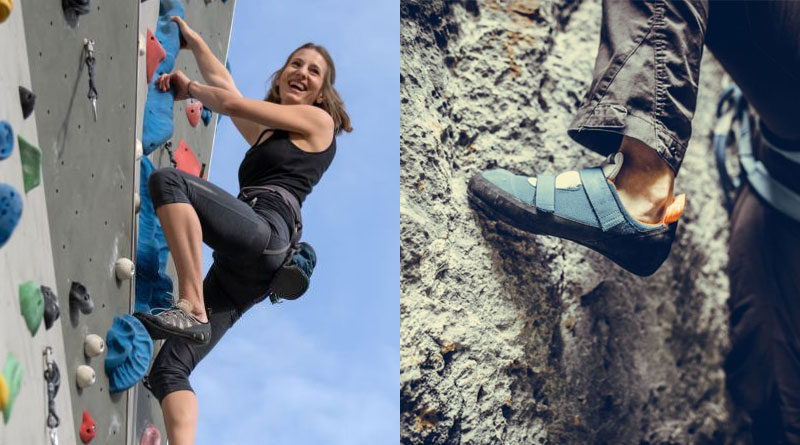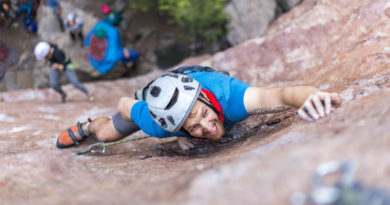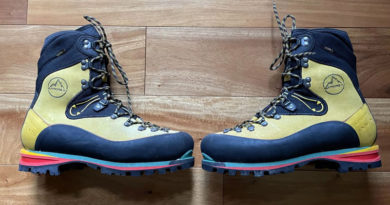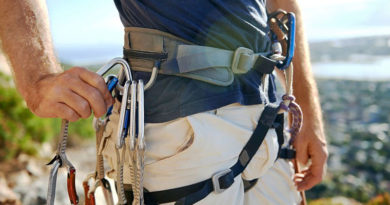Indoor vs. Outdoor Climbing Shoes: The Difference
Climbing shoes are a must-have item for both indoor and outdoor climbers. They offer the necessary grip and support for scaling walls, boulders, and other types of climbing terrain. However, the type of climbing shoes you select can have a significant impact on your climbing experience and performance.
In this blog post, we’ll look at the key differences between indoor and outdoor climbing shoes, as well as their characteristics, benefits, and drawbacks. We’ll also go over factors to consider when deciding between the two types of shoes and offer suggestions for beginners. We’ll also go over some care and maintenance tips to help you get the most out of your climbing shoes. By the end of this post, you’ll know which type of climbing shoe is best suited to your climbing goals and preferences.
Indoor Climbing Shoes
Indoor climbing is a popular sport performed in gyms and other controlled environments. The terrain is typically composed of artificial walls and holds that have been specifically designed for climbing. Indoor climbing shoes are designed to provide the wearer with comfort and support while providing optimal grip on these surfaces.
Indoor climbing shoes typically have a flat or slightly downturned shape, a sticky rubber sole, and a snug fit. The flatter shape improves support on flat holds, and the sticky rubber sole improves grip on plastic surfaces. Furthermore, indoor climbing shoes frequently have a softer sole and more padding to help absorb shock and provide more comfort during long climbing sessions.
Indoor climbing shoes have the advantage of being more comfortable. They are intended for long-term use and can provide better foot support during long climbing sessions. They are also less expensive than outdoor climbing shoes, which makes them an excellent choice for beginners or those on a tight budget.
One disadvantage of indoor climbing shoes is that they may perform poorly on outdoor terrain. The softer sole and lack of an aggressive downturn can make it more difficult to grip onto natural rock formations’ small edges or pockets. These shoes are also less durable than outdoor climbing shoes and may wear out faster with prolonged outdoor use.
Examples of popular indoor climbing shoes include the La Sportiva Tarantulace and the Five Ten Anasazi LV. These shoes are designed with comfort and support in mind and are great options for beginners or those who primarily climb indoors.
Outdoor Climbing Shoes
Outdoor climbing occurs on natural rock formations and terrain, which requires a different shoe than indoor climbing. They are made to provide a better grip on uneven and rough natural rock surfaces.
Outdoor climbing shoes often have an aggressive downturn, a stiffer sole, and a tighter fit. The downturned shape improves grip on natural rock formations’ small edges and pockets, while the stiffer sole provides more support on rough terrain. Furthermore, outdoor climbing shoes frequently have a tighter fit to help increase sensitivity and control while climbing.
These shoes have the advantage of providing a better grip on natural rock surfaces, allowing for greater control and maneuverability. They are also more durable than indoor climbing shoes and can withstand the rigors of prolonged outdoor use.
However, one of the disadvantages of outdoor climbing shoes is that they are often less comfortable. The aggressive downturn and stiffer sole can cause discomfort over time, and some climbers may find the tighter fit uncomfortable. They are also often more expensive than indoor climbing shoes, making them less accessible to beginners or those on a budget.
Examples of popular outdoor climbing shoes include the La Sportiva Solutions and the Scarpa Instinct VS. These shoes are designed with advanced climbers in mind and provide optimal grip and support for outdoor climbing.
Key Differences
The key differences between indoor and outdoor climbing shoes lie in their design and intended use. While both types of climbing shoes provide grip and support, they are designed for different types of terrain and climbing styles.
The shape of the sole is one of the primary distinctions between indoor and outdoor climbing shoes. Outdoor climbing shoes have an aggressive downturned shape, whereas indoor climbing shoes have a flatter or slightly downturned sole. Outdoor climbing shoes have a different shape that allows them to grip onto small edges and pockets found on natural rock formations, whereas indoor climbing shoes are designed for flatter holds on artificial walls.
The stiffness of the sole is another distinction between the two types of shoes. Outdoor climbing shoes typically have a stiffer sole to provide additional support and stability on rough terrain. Indoor climbing shoes, on the other hand, have a softer soles to provide greater comfort over time.
The shoe’s fit is also an important consideration. Outdoor shoes are typically more snugly fitting in order to provide greater sensitivity and control on natural rock surfaces. Indoor shoes, on the other hand, have a looser fit to provide greater comfort over time.
Lastly, the durability of the shoe is another important factor to consider. Outdoor shoes are designed to withstand the wear and tear of extended outdoor use, while indoor climbing shoes may wear out more quickly with outdoor use.
Considerations for Beginners
For beginners, choosing the right climbing shoes can be daunting. Here are a few considerations to keep in mind when selecting indoor or outdoor climbing shoes:
- Comfort: Comfort is important when it comes to climbing shoes, especially for beginners who may not be accustomed to wearing them. Look for shoes with a comfortable fit that doesn’t pinch or rub your feet. Indoor climbing shoes tend to be more comfortable than outdoor climbing shoes, so they may be a better option for beginners.
- Budget: Climbing shoes can be expensive, so it’s important to consider your budget. Indoor climbing shoes tend to be less expensive than outdoor climbing shoes, making them a more accessible option for beginners.
- Terrain: Consider the type of terrain you’ll be climbing on. If you plan on climbing on natural rock formations, outdoor climbing shoes will provide better grip and support than indoor climbing shoes.
- Climbing style: Consider your climbing style. If you plan on doing more bouldering or sport climbing, outdoor climbing shoes may be a better option due to their aggressive downturn and ability to grip onto small edges and pockets. If you plan on doing more top roping or gym climbing, indoor climbing shoes may be a better choice.
- Sizing: Climbing shoes tend to run smaller than regular shoes, so it’s important to try on different sizes before making a purchase. Look for shoes with a snug fit that provides support without being too tight.
In conclusion, choosing the right climbing shoes can make a big difference in your climbing experience. For beginners, it’s important to consider comfort, budget, terrain, climbing style, and sizing when selecting indoor or outdoor climbing shoes. With the right pair of shoes, you’ll be able to climb with confidence and reach new heights.
Conclusion
Whether you’re climbing indoors or outdoors, choosing the right climbing shoes is critical for a comfortable and safe experience. Indoor climbing shoes are intended for use on man-made walls, whereas outdoor climbing shoes are intended for use on natural rock surfaces. Consider terrain, climbing style, comfort, budget, and sizing when choosing climbing shoes.




